I’ve been a huge fan of water chemistry when it comes to all-grain brewing, and it’s helped up my brewing game.
The brewing software I use is BeerSmith, and it does everything I need, except one thing. It fails miserably in calculating my water profile for the beer I’m brewing, specifically the acid additions.
A quick search of BeerSmith vs Bru’n Water, will yield you a number of results on water profile adjustment frustrations.
BeerSmith consistently overestimates the amount of acid required to hit your mash pH targets. While I love the simplicity of BeerSmith and the way it calculates your mineral additions, I can’t rely on it for my acid additions.
That’s led me to use the free version of Bru’n Water. While it works great when it comes to calculating my water profile, it’s one extra step I have to go through every time I put a recipe into BeerSmith.
But wait, BeerSmith just released a new version of their software, version 3.1. A quick glance of the release notes state:
There are new mash pH models available under the mash screen. You can now choose whether to use the MPH model (recommended) or a new BW model. In general the BW model results in similar pH estimates, but the acid additions are significantly lower than the MPH model.
BeerSmith
Could the BW Model be short for Bru’n Water? Has BeerSmith actually improved the way it calculates acid additions?
Is there an opportunity to finally use one piece of brewing software that fit all my requirements?
I decided to do a couple of tests, and compare the water profile adjustment of BeerSmith 3.1 vs Bru’n Water. The results surprised me.
Bru’n Water
My tool of choice for water chemistry has been the free version of Bru’n Water by Martin Brungard. I’ve actually been meaning to purchase the supporter’s version, but I seem to get everything I need out of the free version.
The one downside to Bru’n Water is the need to use a separate program (Excel) to calculate my water profile. This is an extra step in my recipe creation that I could do without. Now granted, it doesn’t take a lot of additional time, but it’s kind of a pain having to enter my grain bill and water information into a spreadsheet.
I also have to manually play with my mineral additions and tweak them ever so slightly to hit my target water profile. Again, not a huge deal, but when you compare it to how BeerSmith automatically calculates the mineral additions, you kind of get spoiled.
BeerSmith Water Profile Calculation
The thing I really dig about BeerSmith is how it handles the water profile calculations. It’s fully automated! Well except for the acid addition part, and it not being accurate.
With BeerSmith 3.0, you entered your existing water profile, just like you would in Bru’n Water. You then selected your target water profile, and it automatically calculated the mineral additions for you. No manual fussing around with mineral additions like you have to do in Bru’n Water.
Unfortunately, the acid addition part left a lot to be desired. It was grossly over estimating the amount of acid required to hit your mash pH. This isn’t just my opinion, a quick Google search will highlight the frustration.
BeerSmith 3.1 vs Bru’n Water
So does BeerSmith 3.1 improve upon the way it calculates your acid additions? Let’s compare the latest release of BeerSmith vs Bru’n Water to find out.
I created three sample recipes in BeerSmith, and used my existing way of calculating the water profile. Which is to say I used Bru’n Water after sorting out the recipe. All recipes used a distilled water profile as the base.
Once I had my water profile dialed in, I then went back to BeerSmith 3.1 to calculate my water profile. I leveraged the water tab in BeerSmith, and selected the same target water profile that I used in Bru’n Water. No changes were made to the water adjustment salts that were automatically calculated in BeerSmith.
The only manual changes made to BeerSmith was to change the acid model to “BW” within the Mash tab. The acid addition was then manually calculated to get the pH to equal what Bru’n Water calculated.
What follows is a comparison of the adjustment salts and acid additions between Bru’n Water and BeerSmith 3.1.
H2O Kolsch
The first test was to create a very light beer, with a minimal grain bill, one where the SRM was right at 3.0. For this I opted to go with a Kolsch recipe, since that’s one of my favorites.
For the target water profile, I went with “yellow balanced”. This got me in the ballpark for the water profile I normally use when brewing a Kolsch.
After manually entering the water additions in Bru’n Water, the water profile adjustment calculator reflected the following:
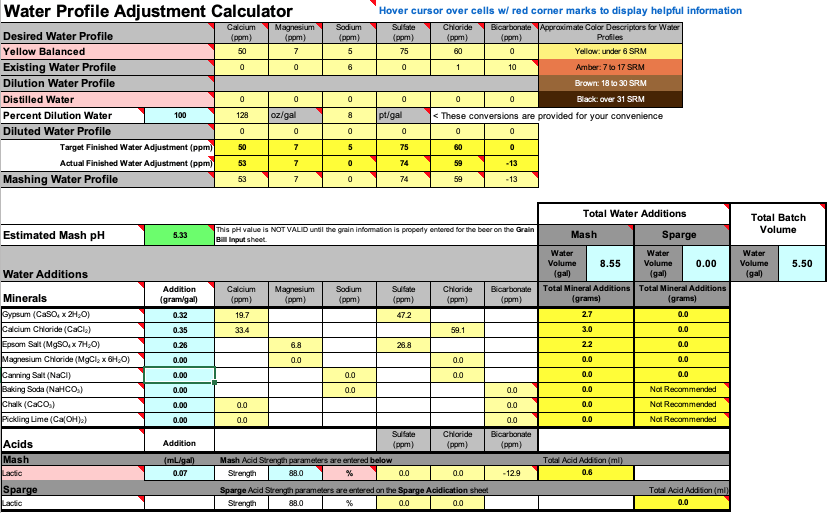
Using BeerSmith 3.1, I let the software automatically calculate my salt additions using the same “yellow balanced” target profile.
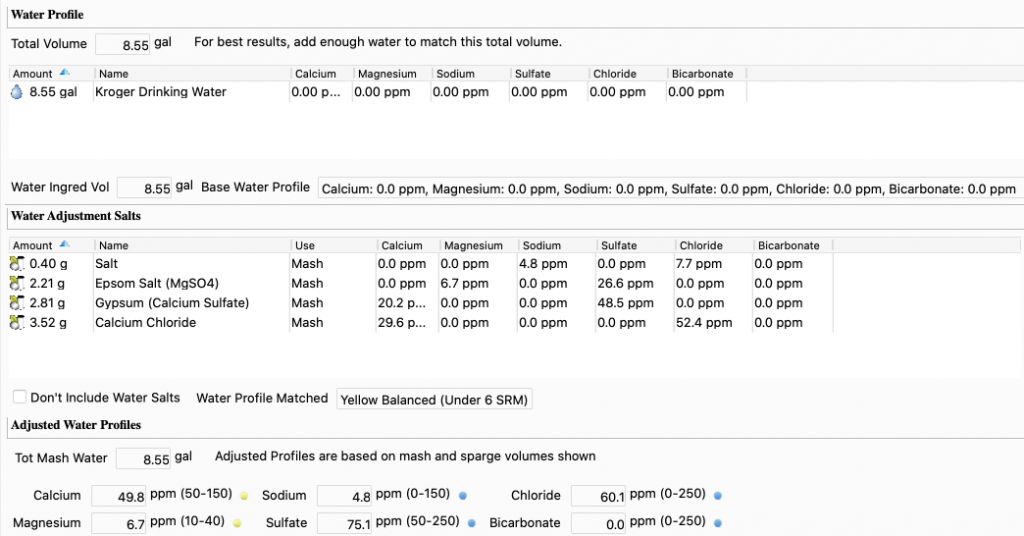
For the acid addition, to get it to equal the 5.33 Estimated Mash pH that Bru’n Water calculated, I used the following:

H2O Kolsch Findings
The salt additions were pretty close across both software packages, and the Lactic Acid addition was spot on.
| Salt Addition | Bru’n Water | BeerSmith |
| Gypsum | 2.7 g | 2.81 g |
| Calcium Chloride | 3.0 g | 3.52 g |
| Epsom Salt | 2.2 g | 2.21 g |
| Lactic Acid (5.33 pH) | .60 ml | .60 ml |
H2O Pale Ale
The second test was for a Pale Ale, using some additional grains including Crystal malt. The SRM for this recipe came in at 6.2.
I went with a “yellow dry” water profile for this batch, which is what I typically use when brewing a Pale Ale.
After manually entering the water additions in Bru’n Water, the water profile adjustment calculator reflected the following:
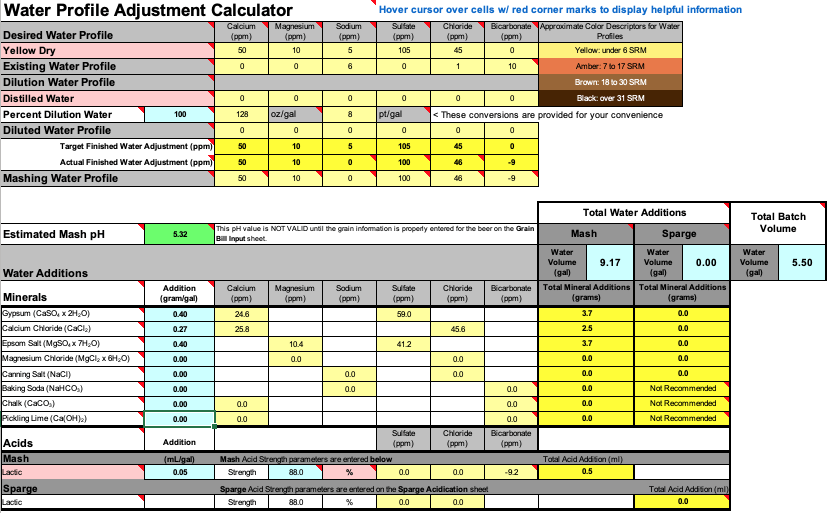
Using BeerSmith 3.1, I again let the software automatically calculate my salt additions using the same “yellow dry” target profile.
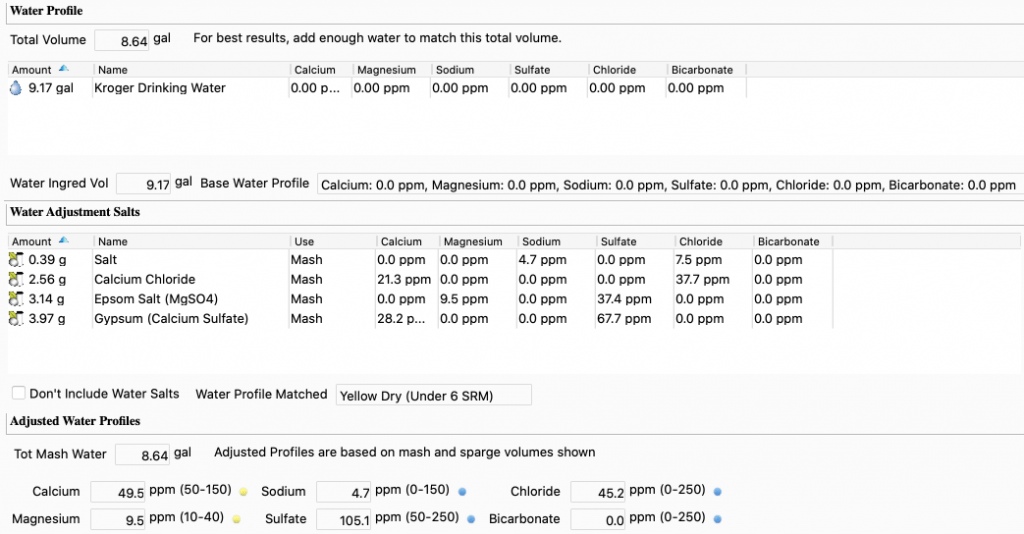
For the acid addition, to get it to equal the 5.32 Estimated Mash pH that Bru’n Water calculated, I used the following:

H2O Pale Ale Findings
Again, the salt additions were pretty damn close across both packages, and the Lactic Acid addition was exactly the same. I did like the fact that BeerSmith calculated less Epsom Salt, than my additions using Bru’n Water. Looks promising so far.
| Salt Addition | Bru’n Water | BeerSmith |
| Gypsum | 3.7 g | 3.97 g |
| Calcium Chloride | 2.5 g | 2.56 g |
| Epsom Salt | 3.7 g | 3.14 g |
| Lactic Acid (5.32 pH) | .50 ml | .50 ml |
H2O Irish Stout
For the third and final test, I went with a darker beer, an Irish Stout. This gave me the opportunity to try out some roasted grains in the test, and go with a slightly higher pH target of 5.4. I also figured there would be a need to add a Bicarbonate to raise the mash pH.
For this Irish Stout, I used a “black dry” water profile.
After manually entering the water additions in Bru’n Water, the water profile adjustment calculator reflected the following:
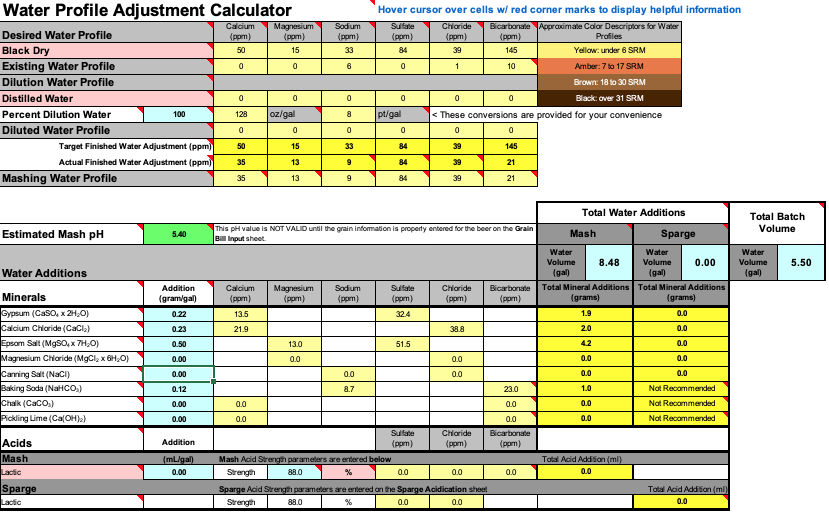
No surprise that I didn’t need to add any acid to lower the mash pH, given the 10% Black Barley in the grist.
Using BeerSmith 3.1, I also let the software automatically calculate my salt additions using the same “black dry” target profile.
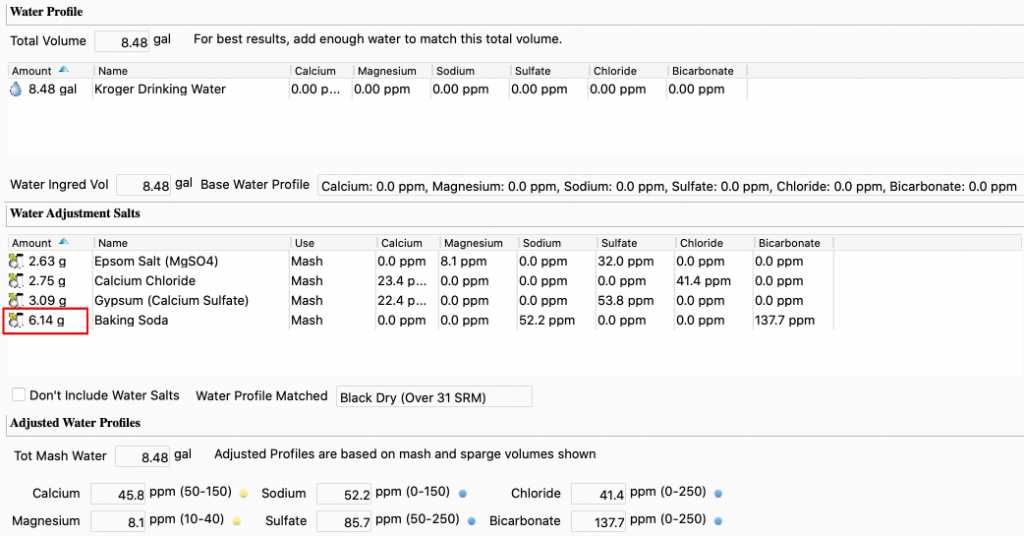
Note the hefty addition of Baking Soda to raise the mash pH.
Surprisingly, in order to hit my 5.4 mash pH target, I needed to add a pretty decent dose of acid to lower the mash pH:

H2O Irish Stout Findings
These results surprised me, especially given how close the previous two tests were.
The salt additions varied considerably compared to the previous two tests. Most surprising was BeerSmith having me add a very large dose of Baking Soda, and then offsetting that with a large dose of Lactic Acid to hit my mash pH.
| Salt Addition | Bru’n Water | BeerSmith |
| Gypsum | 1.9 g | 3.09 g |
| Calcium Chloride | 2.0 g | 2.75 g |
| Epsom Salt | 4.2 g | 2.63 g |
| Baking Soda | 1.0 g | 6.14 g |
| Lactic Acid (5.40 pH) | 0 ml | 5.15 ml |
Keep in mind, I was using the automated feature of BeerSmith to calculate my mineral additions.
If I was actually brewing this beer, seeing these results, it would have raised a major red flag. I would have manually overrode some of that Baking Soda so it wasn’t raising my mash pH as much. That way I would be able to avoid the acid addition.
BeerSmith 3.1 vs Bru’n Water Conclusion
So how does the new release of BeerSmith 3.1 compare to Bru’n Water?
We set out to understand if the new release of BeerSmith 3.1 improved upon the way it calculates acid additions.
What I found was BeerSmith does indeed improve the way it calculates your water profile. In fact, for standard yellow beers the acid additions are identical.
With that said, it does appear there’s some nuances when it comes to darker beers that contain roasted grains. As long as you are aware of that, and spot check the automated calculation of mineral additions, I don’t find this to be a deal breaker.
Will I start using BeerSmith in place of Bru’n Water to calculate my water profile? Yea, I’m going to start giving it a shot. It’s one less step in the brewing process for me, as I don’t need to use another piece of software to calculate my water profile.
I will add a caveat to the above statement. At least for the first few beers that I’m brewing, I will be double checking things using Bru’n Water.
Let me know what you think.
Cheers…
Just to make sure, you are taking pH readings at room temp right? I find this important distinction is never made.
Great point. Yes, I take all my readings at room temp, or at least something close to that.
I just noticed that the salt calculations are different between BS and BruNwater, what do you think that cause this?
They use a different method of calculating. In the last BS release they added the option of using the same methodology that BruNwater uses.